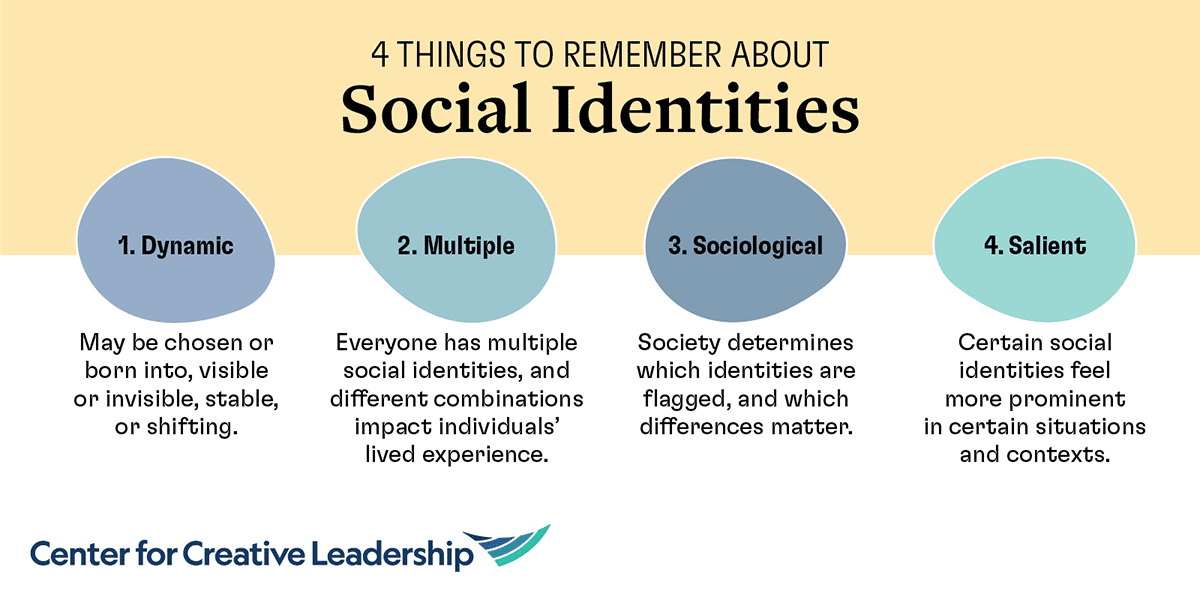Today’s global workforce is more diverse than ever before. Leaders who want to tap the potential of everyone on their teams and harness the power of their diverse experiences must understand how to lead multicultural teams and build a climate of respect at the organization.
To do this, they must understand and consider their team’s different perspectives and lived experiences. This starts with understanding social identity — both others’ and their own.
4 Things to Know About Social Identity
Some Guidance for Leaders
To understand how social identity can inform your leadership, it’s helpful to remember that social identities are:
- Dynamic,
- Multiple,
- Sociological, and
- Salient.
1. Social identities are dynamic.
There’s no one specific way to acquire a social identity. You could be born into a social identity group (e.g., being born into a given generation) or acquire one as a result of specific choices made (e.g., becoming a doctor). Still other times, a lived experience may create a new social identity (e.g., an accident or illness may change your ability status). Some social identities are visible, while others are invisible. Some social identities you may hold your whole life, while others may shift throughout your life. Social identity isn’t static; it can change over time.
2. Everyone has multiple social identities, and combinations matter.
Although social identity is often talked about in terms of a single category (e.g., “Republican or Democrat;” “Black or White”), everyone actually has multiple social identities that combine together in unique ways that influence our lived experiences and interactions. For example, the experience of being White is likely to be different if a person is also rich, heterosexual, and cisgender, as compared to a person who is poor, queer, and non-binary.
3. Social identities are shaped by society.
Society and culture determine when and how differences between people become social identities. For example, eye color is not considered a social identity in most current social groups, but skin color is. Because social identities are norm-dependent, what is and is not considered a social identity can change over time and in different cultures.
4. Social identities can be more or less salient, depending on context.
Certain social identities may feel more prominent in certain situations and contexts. For example, if you are a White American living in North America, you might not often think about your national identity. However, if you were to take an expat position in China, this might suddenly feel like a huge part of your identity, because it will likely impact how others see you, as well as how you interpret your experiences.
Access Our Webinar!
Learn more about the relationship between various aspects of social identity — both your own and that of others — and how they can have a connection to unconscious bias when you watch our webinar, How Aspects of Identity Can Affect the Way You Lead & Work With Others. Understanding how social identity affects your own leadership will make you more effective and better able to foster greater equity and inclusion in your organization.
Understanding Your Own Social Identity
An Exercise to Help You Explore Your Social Identity
To bring focus to the way social identity impacts how you work and lead others, try this exercise.
1. List as many of your own social identities as you can.
Consider categories such as race, sex, gender expression, ethnicity, religion, generation, occupation, nationality, sexual orientation, social or relational roles (such as parenting or caregiving and leadership roles), (dis)ability, neurotypical status, etc.
2. Reflect on these social identities you’ve listed.
Consider the following questions:
- Which social identities are most central to how you see yourself as a person? Why?
- Which social identities have the biggest impact on how others treat you? Why? Does your answer change depending on context (e.g., at work, at home, with your friends)?
- Are there aspects of your identity that you keep hidden at work? What impact might that have on you and those around you? Are there aspects you try to make explicitly known about you? What impact does that have on how you move through the world?
- What assumptions do you think other people make about you based on your social identities?
- What assumptions may you have made about other people based on their social identities?
3. Consider how your various social identities have an impact on you.
Does your social identity affect your:
- Access to various types of support, resources, and people in positions of authority?
- Ability to direct your own and other people’s work?
- Authority to make decisions?
- Ability to influence through position or relationships?
How to Lead With Social Identity in Mind
3 Tips for Leaders
Not all of these strategies are appropriate for every group or organization, but some of them may be useful to you. You can also generate your own strategies to fit your specific situations.
1. Notice social identity representation at your organization.
Pay attention to how social identities play out in your work group and organization. Is there diversity within the front lines of your organization, but less so among the decision-makers? Is there diversity among the decision-makers, but less among certain groups?
Once you notice who’s missing, consider how you could increase representation among the social identities you’re not hearing from. Make an intentional effort to increase representation of different social identities where possible, and consider how inclusive leadership practices could help.
2. Facilitate routine contact across social identities.
One of the simplest and best established strategies to decrease bias and stereotyping is to cultivate contact between people from different social identity groups to increase opportunities for collaboration across boundaries wherever you can. Consider which social identity groups do not often interact in your current work structure, and how you might arrange more chances for connection (e.g., cross-functional projects, social events, retreats, or team-building activities). Relationship-building starts with showing empathy and genuine interest in including others, and leaders should keep this in mind to build belonging at work.
3. Use your understanding of social identity to elevate equity at your organization.
Leading with compassion and understanding social identity can help reveal opportunities to elevate equity. Equity is about giving people the resources they need to succeed (which is different from equality, which is about giving everyone the same resources). Organizational diversity & inclusion initiatives can be less effective if they don’t lead with equity first.
For example, when creating a new HR policy, examine how it may impact people differently at your organization based on different combinations of social identities. Pay special attention to social identities that may be underrepresented or historically oppressed or underestimated. For example you might ask, How might this new hybrid work policy impact people of color? Caregivers? Disabled people? Non-binary team members? Older workers without college educations?
If it seems like the policy could create an additional burden on certain groups, consider how you could adjust it, and be sure to check with others who have social identities likely to be impacted. Inviting them to share their input directly, and actively listening to understand their perspectives can go a long way toward attracting, retaining, and engaging talent at your organization.
Ready to Take the Next Step?
Upskill your managers’ ability to understand social identity and its impact on their leadership with a customized learning journey using our research-based modules. Available leadership topics include Emotional Intelligence, Listening to Understand, Psychological Safety, Self-Awareness, and more.











Social Identity Explained
What Is Social Identity?
Social identities are labels that people use to categorize or identify themselves and/or others as members of specific groups. Some common social identities include generation, ethnicity, race, religion, gender, sexual orientation, nationality, (dis)ability, political affiliation, relationship status, profession, and socioeconomic status.
Social identity is one of the aspects of your “self-concept” — how you see yourself as a person. Along with your personal identity (e.g., personal attributes you use to describe yourself, like being tall or conscientious), social identity influences our values, the stories we tell about ourselves and others, and things that motivate us toward action.
Why Does Social Identity Matter?
Social identities are powerful because they’re also often at the root of unequal power or privilege. As humans, we categorize ourselves and each other into groups along social identity lines. This categorization often lays the foundation for bias, stereotypes, prejudice, and favoritism. It also often serves as a catalyst for action (e.g., we may feel motivated to mobilize, organize, and/or speak out on behalf of others to show allyship based on social identity).
Understanding the nuances of social identity is critical for any people leader, because aspects of social identity affect how you lead and work with others. Approaching situations through a lens of social identity awareness can help you spot cases where people don’t feel enough psychological safety at work to share their perspectives freely, or when actions or decisions may be rooted in unconscious bias.
Understanding social identity is also foundational to any organizational-level efforts to take action on DEI in the workplace and foster a more inclusive culture, which yields an organization that is more innovative, successful, and better prepared for the future.